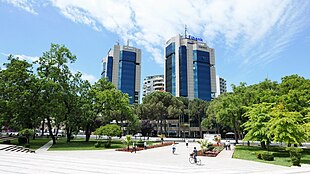
Back اقتصاد ألبانيا Arabic Economía d'Albania AST Albaniya iqtisadiyyatı AZ Албания иҡтисады BA Эканоміка Албаніі BE Эканоміка Альбаніі BE-X-OLD Икономика на Албания Bulgarian Economia d'Albània Catalan Ekonomika Albánie Czech Albaniens økonomi Danish
 Tirana, the economic hub of Albania | |
| Currency | Lek (ALL, L) |
|---|---|
| Calendar year | |
Trade organisations | WTO, BSEC, CEFTA, Open Balkan |
Country group |
|
| Statistics | |
| Population | 2,402,113 (2023)[4] |
| GDP | |
| GDP rank | |
GDP growth |
|
GDP per capita | |
GDP per capita rank | |
GDP by sector |
|
| 3.0% (2025)[5] | |
Population below poverty line | |
| 33.0 medium (2021)[9] | |
| 37 out of 100 points (2023)[12] (98th) | |
Labour force | |
Labour force by occupation |
|
| Unemployment |
|
Average gross salary | ALL 75.025 / €750 / $790 monthly (Q4, 2023) |
| $680 per month | |
Main industries | footwear, apparel and clothing; lumber, oil, cement, chemicals, mining, basic metals, Food and beverages, hydropower, auto parts |
| External | |
| Exports | $4.39 billion (2022 est.)[3][16] |
Export goods | apparel and clothing, footwear; asphalt, metals and metallic ores, crude oil; cement and construction materials, vegetables, fruits, tobacco, processed foods and beverages, hydropower, automotive parts |
Main export partners |
|
| Imports | $7.75 billion (2021)[3] |
Import goods | machinery and equipment, foodstuffs, textiles, chemicals |
Main import partners | |
FDI stock |
|
| −$1.050 billion (2022)[3] | |
Gross external debt | $8.5 billion (2023)[3] |
| Public finances | |
| 55.5% of GDP (2024)[18] | |
| −3% (of GDP) (2022)[3] | |
| Revenues | 5.4 billion (2022)[3] |
| Expenses | 6.4 billion (2022)[3] |
| Economic aid | recipient: ODA: $366 million (top donors were Italy, EU, Germany) (2003) |
| |
| $5.634.561 billion (2021)[20] | |
All values, unless otherwise stated, are in US dollars. | |
The economy of Albania went through a process of transition from a centralized economy to a market-based economy on the principles of the free market.
Albania's economy is based on the service (54.1%), agriculture (21.7%), and industrial (24.2%) sectors.[3] The country has some natural resources, and the economy is mainly bolstered by agriculture, food processing, lumber, oil, cement, chemicals, mining, basic metals, hydro power, tourism, textile industry, and petroleum extraction. The strongest sectors are energy, mining, metallurgy, agriculture, and tourism. Primary industrial exports are clothing and chrome.
Tourism has been a notable source of national income, particularly during the summer months. With over 6.4 million tourists visiting Albania in 2019, tourism generates revenue in excess of $2.4 billion annually.[21]
- ^ "World Economic Outlook Database, April 2019". IMF.org. International Monetary Fund. Retrieved 29 September 2019.
- ^ "World Bank Country and Lending Groups". datahelpdesk.worldbank.org. World Bank. Retrieved 29 September 2019.
- ^ a b c d e f g h i j k l "Albania". CIA.gov. Central Intelligence Agency. 25 November 2024.
- ^ "Population of Albania, September 2024". Institute of Statistics - Tirana. Retrieved 2 February 2023.
- ^ a b c d e f "World Economic Outlook database: April 2024". IMF.org. International Monetary Fund.
- ^ "Poverty headcount ratio at national poverty lines (% of population)". data.worldbank.org. World Bank. Retrieved 18 February 2023.
- ^ "Poverty headcount ratio at $6.85 a day (2017 PPP) (% of population) - Albania". data.worldbank.org. World Bank. Retrieved 18 February 2023.
- ^ "People at risk of poverty or social exclusion by sex". Eurostat. Retrieved 13 October 2023.
- ^ "Gini coefficient of equivalised disposable income - EU-SILC survey". Eurostat. Retrieved 28 March 2023.
- ^ "Human Development Index (HDI)". Human Development Report HDRO (Human Development Report Office) United Nations Development Programme. Retrieved 24 September 2022.
- ^ "Inequality-adjusted HDI (IHDI)". United Nations Development Programme. Retrieved 13 October 2022.
- ^ "Corruption Perceptions Index". Transparency International. 30 January 2024. Archived from the original on 30 January 2024. Retrieved 15 July 2024.
- ^ "Labor force, total - Albania". data.worldbank.org. World Bank. Retrieved 11 January 2020.
- ^ "Anketa Tremujore e Forcave të Punës" (PDF). instat.gov.al. INSTAT. Retrieved 12 December 2022.
- ^ "Anketa Tremujore e Forcave të Punës" (PDF). instat.gov.al. 2022. Retrieved 12 December 2022.
- ^ Simoes, Alexander. "Albania 2021, export/import". Observatory of Economic Complexity. Retrieved 13 January 2020.
- ^ a b "Foreign trade partners of Albania". The Observatory of Economic Complexity. Retrieved 7 April 2023.
- ^ "Buletini Statistikor I Borxhit" [Debt Statistical Bulletin] (PDF) (in Albanian). Ministry of Finance and Economy (Albania). 31 March 2020. Archived (PDF) from the original on 2020-11-19.
- ^ "Sovereigns rating list". SEENews: Business Intelligence for South East Europe. 6 February 2017. Archived from the original on 6 February 2017. Retrieved 12 July 2017.
Standard & Poor's said it has raised its long- and short-term foreign and local currency sovereign credit ratings on Albania at C+ with a stable outlook.
- ^ "Albania International reserves, 1960-2018". Knoema. Retrieved 13 January 2020.
- ^ "Albania tourism data". worlddata.info. Retrieved 2 February 2023.